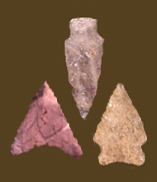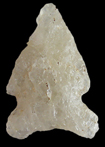
|
OTTER CREEK
A medium to large, thick, narrow to medium-wide, side notched point with well-formed tangs and a concave base. Chronology The Otter Creek point is variously placed in the Middle and Late Archaic periods. Kinsey (1972) reports radiocarbon dates associated with Otter Creek components in the Northeast that range from 4610 +/- 100 BC to 2270 +/- 160 BC (approximately 5475-2850 BC in calendar years). However, most researchers suggest the core period of Otter Creek manufacture occurred between 6000 and 5000 BP (roughly 4850-3800 BC in calendar years) (Steponaitis 1980; Funk 1993; Dent 1995). Description Blade: The blade is ovoid or lanceolate, with edges that are usually excurvate, but sometimes straight. Shoulders are usually the same width as -- or narrower than -- the basal tangs, but can be wider. Haft Element: The stem is side notched; notching seems to have been a final operation, usually resulting in well-defined square tangs, but some examples have rounded tangs. The base is usually concave, but can be straight. Usually the base, tang edges, and notches were ground. On some examples, the base has been thinned. Size: Length ranges from 25 to 114 mm. Ritchie (1971) indicates that a majority fall between 70 and 89mm, but others report a smaller average length; at the Higgins site, the points ranged from 25 to 59 mm (Ebright 1992; see also Kinsey 1972). Width ranges from 18 to 28 mm, and thickness from 6 to 13 mm. Technique of manufacture: Manufacture was done by percussion, with secondary marginal pressure flaking common. Material: At the Higgins site in Anne Arundel County, 56% of 24 Otter Creek points were quartz, with 40% rhyolite and 4% quartzite (Ebright 1992). In a sample of 12 Otter Creek points from the lower Patuxent drainage, Steponaitis (1980) reported that 59% were rhyolite, followed by quartzite (25%) and quartz (16%). In the area surrounding Zekiah Swamp on the lower Potomac, Wanser (1982) found that 65% of 26 Otter Creek points were quartz, with 31% quartzite and 4% rhyolite. In the Monocacy River drainage, 90% of 122 Otter Creek points were rhyolite, with 6% quartz and 4% chert (Kavanagh 1982). Of 11 Otter Creek-like points reported from the Hagerstown Valley, 64% were rhyolite, 27% chert, and 9% quartzite (Stewart 1980). In the middle Potomac Valley, chert Otter Creek are most common, but other local materials are used (Hranicky 2002). In the middle Potomac Valley, chert Otter Creek are most common, but other local materials are used (Hranicky 2002). Discussion At the Higgins site, Otter Creek points do not appear to have functioned as projectiles. They often exhibited heavy unilateral blade edge dulling, combined with polish on the flake scar ridges on one adjacent face, suggesting use as a scraper. Despite the unilateral wear, even exhausted blades maintained their symmetry relative to the base. However, many of the heavily re-worked Otter Creek points, particularly the rhyolite ones, had an asymmetric cross-section and an occasional resemblance to Brewerton Eared Notched points (Ebright 1992). Defined in Literature References |
![]()
Search by Shape:
(See Projectile Point Typology) |

|
Thank you for visiting our website. If you have any
questions, comments, Copyright © 2002 by |

|

 Defining Attributes
Defining Attributes